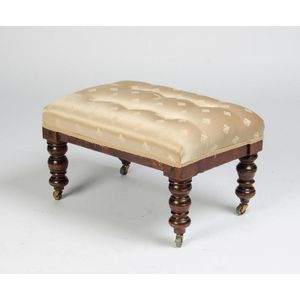Victorian Aesthetic Mahogany Dining Chairs by Lamb of Manchester
You must be a subscriber, and be logged in to view price and dealer details.
Subscribe Now to view actual auction price for this item
When you subscribe, you have the option of setting the currency in which to display prices to $Au, $US, $NZ or Stg.
- Victorian Period - The Victorian period of furniture and decorative arts design covers the reign of Queen Victoria from 1837 to 1901. There was not one dominant style of furniture in the Victorian period. Designers used and modified many historical styles such as Gothic, Tudor, Elizabethan, English Rococo, Neoclassical and others, although use of some styles, such as English Rococo and Gothic tended to dominate the furniture manufacture of the period.
The Victorian period was preceded by the Regency and William IV periods, and followed by the Edwardian period, named for Edward VII (1841 ? 1910) who was King of the United Kingdom and the British Dominions and Emperor of India for the brief period from 1901 until his death in 1910. - Mahogany - Mahogany is a dense, close grained red-coloured timber from the West Indies and Central America. It was first imported into Europe in the the early 18th century and its use continued through the 19th century. It was popular for furniture making because of its strength, the wide boards available, the distinctive grain on some boards, termed flame mahogany and the rich warm colour of the timber when it was polished.. The "flame" was produced where a limb grew out from the trunk of the tree, and this timber was usually sliced into veneers for feature panels on doors, backs and cornices.
Some terms used to describe mahogany relate to the country from which it originally came, such as "Cuban" mahogany, "Honduras" mahogany etc. However unless the wood has been tested the names assigned are more a selling feature, rather than a true indication of the timber's origin. - Lamb of Manchester - James Lamb (1816-1903), founded a cabinet-making workshop in Manchester which flourished during the boom years of the Industrial Revolution. The firm was renowned for their richly upholstered, finely carved Victorian furniture including dining chairs, settees and cabinets.
They exhibited at the 1862 London Universal Exhibition, and in Paris in 1867 and 1878, winning several awards.
Principally associated with the Aesthetic Movement, Lamb worked in association with several key designers of the period including Alfred Waterhouse, Bruce Talbert and Charles Bevan.
This item has been included into following indexes:
-
chairs, sets of 4, style or period
- all styles 511
- Victorian 139
- chairs, sets of 4, timber - mahogany 104
- furniture, period or style - Aesthetic movement 76
- Lamb of Manchester (England) - furniture makers 5
Visually similar items

Two Indian silvered throne chairs, each of impressive proportions, ornately cast with lion mounted arms and crests, the padded seat above a conforming frieze raised on lions paw cabriole legs, the tallest 159 cm high. Provenance: Reputedly from the Gol Est

An Australian cedar extension dining table with three leaves, circa 1870, the rectangular top with rounded ends above a plain frieze, raised on bulbous turned legs with ceramic castors, 125 cm wide, x 125 cm deep, 76 cm high, 238 cm long extended

A Victorian gold upholstered foot stool. 35 cm high, 60 cm wide, 40 cm deep

An elaborate marquetry and gilt metal mounted centre table 83 cm high, 123 cm wide, 53 cm deep
